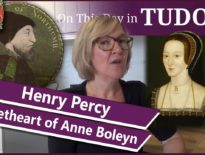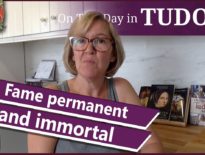On this day in Tudor history, 28th June 1557, Philip Howard, 13th Earl of Arundel, was born at Arundel House, the Strand, London.
Philip ended up being condemned to death for treason and dying of alleged poisoning in 1589, when he was just 32, so let me tell you a bit more about him and what led him to that very sticky end.
Also on this day in Tudor history, 28th June 1491, King Henry VIII was born at Greenwich Palace. Find out more about Henry, his life and reign in last year’s video:
Also on this day in history:
- 1461 – Coronation of Edward IV at Westminster Abbey.
- 1497 – Execution of Sir James Tuchet, 7th Baron Audley, by beheading at Tower Hill. Like Flamank and Joseph, who were executed the previous day, he was one of the chief commanders of the Cornish rebels in the 1497 Cornish rebellion. The three commanders were captured after the rebels were beaten at the Battle of Blackheath in London.
- 1516 – Birth of Charles Blount, 5th Baron Mountjoy, courtier and educational patron. He was born in Tournai to William Blount, 4th Baron Mountjoy, and his third wife, Alice Brown, while his father was governor of Tournai. Mountjoy received an excellent humanist education and was tutored by the likes of Jan van der Cruyce, a friend of Erasmus, and Petrus Vulcanius of Bruges. Scholars such as Erasmus, Juan Luis Vives and John Leland dedicated works to Mountjoy.
- 1536 – Death of Richard Pace, diplomat, humanist, administrator and Dean of St Paul's, Exeter and Salisbury. He was buried in the church of St Dunstan in Stepney. Pace served Cardinal Wolsey as his Secretary, and was appointed Henry VIII's Personal Secretary in 1516. He was imprisoned for some time in 1528 and 1529 after being critical of the King's desire for an annulment. Pace suffered with ill health from 1522 onwards, which included fits, gastric problems and possible bipolar disorder.
- 1541 – Execution of Leonard Grey, Viscount Graney and Lord Deputy of Ireland, on Tower Hill. He was executed for treason after being accused of abusing his authority, encouraging attacks on the King's subjects and having Geraldine sympathies.
- 1558 – Death of Thomas Darcy, 1st Baron Darcy of Chiche, courtier, soldier and administrator, at Wivenhoe. He was buried at St Osyph's Priory. Darcy served as Captain of the Gentlemen Pensioners in the Scottish campaign of 1547, was a member of the Privy Council in 1550 and served as Lord Chamberlain of the Household. He was arrested after he supported Northumberland's bid to put Lady Jane Grey on the throne, but was pardoned in November 1553.
- 1598 – Death of Abraham Ortelius, map maker, at Antwerp. He was buried in Antwerp's church of St Michael. Ortelius is known as the creator of the first modern atlas, the Theatrum Orbis Terrarum (Theatre of the World), which was published in 1570.
- 1603 – Death of Sampson Erdeswick, Catholic recusant and antiquary, at Sandon in Staffordshire. He was buried in the local church. Erdeswick claimed to be the real author of “The True Use of Armorie”, which had been published in 1592 under the name of William Wyrley, his assistant. His “A Survey of Staffordshire” was published after his death.
- 1621 – Death of Sir Richard Bulkeley, landowner and courtier, at Hen Blas, Beaumaris, Anglesey. He was buried at Beaumaris Church. Bulkeley owned lands in Anglesey and Cheshire.
Transcript:
On this day in Tudor history, 28th June 1557, Philip Howard, 13th Earl of Arundel, was born at Arundel House, the Strand, London.
Philip ended up being condemned to death for treason and dying of alleged poisoning in 1589, when he was just 32, so let me tell you a bit more about him and what led him to that very sticky end.
• Philip was born on this day in 1557 and was the only child of Thomas Howard, 4th Duke of Norfolk, and his first wife, Mary Fitzalan, second daughter and co-heir of Henry Fitzalan, 12th Earl of Arundel.
• When he was baptised in Whitehall Palace’s chapel royal on 2nd July 1557, Mary I’s husband, Philip of Spain, and Nicholas Heath, Archbishop of York, stood as his godfathers, and Elizabeth Howard, dowager duchess of Norfolk, stood as his godmother. Sadly, his mother died less than a month after his birth.
• As a child, Philip was known by the courtesy title of Earl of Surrey.
• In 1569, when he was 12, Philip married twelve-year-old Anne Dacre, eldest daughter of Thomas Dacre, 4th Lord Dacre of Gilsland. The marriage was properly solemnised when the couple turned 14 in 1571.
• In 1572, Philip’s father was executed for treason and Philip lost his title of Earl of Surrey, although he was allowed to retain most of the family’s property.
• In 1576, he graduated MA from St John’s College, Cambridge, and then moved to the royal court of Elizabeth I, leaving his wife in the country while he resided in London in Howard House. He hosted the queen at his estates of Kenninghall and Mount Surrey on her progress in 1578, upsetting his maternal grandfather and aunt with his lavish spending on entertainment for the queen, which led to him being in debt and having to sell some of his and his wife’s properties.
• His maternal grandfather, the Earl of Arundel, died in 1580 and Philip became Earl of Arundel. Philip became wealthy, owning Arundel Castle in Sussex and Arundel House in London, as well as other estates and properties.
• Philip and his wife had two children together, Elizabeth, born in 1583, who died in her teens, and Thomas Howard, 14th Earl of Arundel, born in 1585.
• Philip’s wife, Anne, converted to Catholicism in the 1580s, during the Protestant reign of Queen Elizabeth I, and was open about her conversion. Philip, who had been brought up a Protestant, also began to favour the Catholic faith, although he hid this from the queen. However, the fact that he didn’t condemn his wife’s beliefs led him into trouble and in December 1583 he was interrogated about harbouring Thomas Heywood, a Jesuit priest, and placed under house arrest until the following April.
• In September 1584 at Arundel Castle, Philip officially converted, being received into the Catholic Church by William Weston, a Jesuit priest. He still kept his faith hidden and began planning to go into exile abroad.
• In April 1585, after writing the queen a letter explaining his reasons for leaving England, his religious conscience, but assuring the queen that he was still her loyal servant, Philip set sail from Littlehampton on the Sussex coast, leaving his pregnant wife and daughter behind. Unfortunately, he was apprehended in the English channel, when his ship was boarded, and he was escorted to the Tower of London.
• Philip was taken before the Star Chamber and accused of being a Roman Catholic, leaving the country without the queen’s permission, and claiming the dukedom of Norfolk. In May 1586, he was fined £10,000.
• Nearly three years later, in April 1589, he was tried, attainted and condemned to death in April 1589, after another Catholic claimed, while being tortured, that during their time in the Tower, Philip had arranged a secret mass for the success of the Spanish Armada. However, the queen did not sign his death warrant and he kept his head and remained in prison, where he worked on religious translations and treatises on virtue.
• In August 1595, after over ten years of imprisonment, Philip became ill. He asked the queen’s permission to see Anne and their children, and the queen replied “If he will but once attend the Protestant Service, he shall not only see his wife and children, but be restored to his honors and estates with every mark of my royal favor.” Philip remained firm in his faith and refused. He died at the Tower of London on 15th October 1595, some sources state 19th, from dysentery or malnutrition, although it was rumoured that he had been poisoned by his cook, who allegedly poisoned the sauce of a roasted teal. On 22nd October 1595, Philip was laid to rest in the Chapel of St Peter ad Vincula at the Tower of London. In 1624, his widow and son arranged for his remains to be brought to the Countess’s home at West Horsley in Surrey, where they were put in an iron coffin before being taken to the Fitzalan Chapel of Arundel Castle and buried in a vault. In 1971, his remains were moved once more, this time to Arundel Cathedral. His son, Thomas, was restored in blood as 14th Earl of Arundel in 1604.
• Philip was beatfied in 1929 and then canonised as a Catholic martyr in 1970. In 1973, his resting place, Arundel Cathedral, was dedicated to “Our Lady and St Philip Howard”.



Leave a Reply